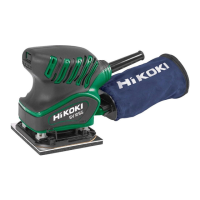
 Loading...
Loading...
Do you have a question about the Hitachi SV12SG and is the answer not in the manual?
| Power | 200 W |
|---|---|
| Length (max) | 137 mm |
| Dust container type | Dust bag |
| Soft grip | Yes |
| Product color | Black, Green |
| Type of sander | Orbital sander |
| Eccentricity | 0.75 mm |
| Idle speed (max) | 14000 RPM |
| Sound power level | 79 dB |
| Oscillating orbit diameter | 1.5 mm |
| Idle oscillation rate (max) | 28000 OPM |
| Power source | AC |
| Weight | 1100 g |
|---|---|
| Sanding plate size (WxD) | 110 x 100 mm |
Explains the meaning of signal words like WARNING and CAUTION.
Outlines fundamental safety precautions for operating power tools.
Details specific safety rules and symbols relevant to the tool's operation.
Identifies and labels the various parts of the orbital sander.
Lists technical specifications of the power tool, including voltage and speed.
Describes the intended uses and applications of the orbital sander.
Covers essential checks and preparations before using the tool.
Instructions for attaching quick stick sanding paper to the pad.
Guide on how to connect and disconnect the dust collection bag.
Details on how to properly hold, move, and switch the sander on/off.
Steps for fitting optional accessories like sponge pads or felt pads.
Procedure for bending and installing clip-type sanding paper.
Instructions for attaching Velcro-type sanding paper to the sponge pad.
Using a punch plate to create dust collection holes in sandpaper.
Guidance on emptying and maintaining the dust collection bag.
Advice on checking the condition and replacing worn parts like paper, screws, and brushes.
Guidelines for performing maintenance and repairs by qualified personnel only.
Lists the accessories included as standard with the tool.
Details optional accessories available for purchase and their specifications.